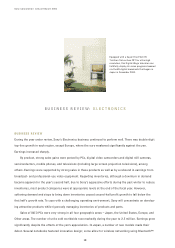Sony 2001 Annual Report Download - page 26
Download and view the complete annual report
Please find page 26 of the 2001 Sony annual report below. You can navigate through the pages in the report by either clicking on the pages listed below, or by using the keyword search tool below to find specific information within the annual report.
Sony Corporation Annual Report 2001
24
services involving this recording medium. Support for the Memory Stick has extended well beyond the
electronics industry. Thus, Sony believes that the Memory Stick is now firmly established as a network
medium that facilitates the easy exchange of many types of content, such as images, music, and data.
Sony is currently developing ways to give the Memory Stick smaller dimensions, more capacity and a
higher data transfer rate. Accompanying this work is the development of products that utilize the medium in
new ways and create new forms of enjoyment for electronics products, such as expansion modules equipped
with new functions. In the future, Sony intends to add camera, GPS, fingerprint-matching, and wireless
communication functions to Memory Sticks.
Sony and other companies that support the Memory Stick format are working to offer new lifestyles that
take advantage of the possibilities of Memory Stick. In Japan, multimedia kiosks with slots for direct
insertion of Memory Sticks are being placed in convenience stores. Customers need merely insert a Memory
Stick to print an image from a digital camcorder or digital still camera.
In the area of non-contact IC card-related technology, Sony has developed FeliCa. It offers excellent
security, high speed, and simultaneous data processing. The card needs only to be passed over a reader/
writer unit to perform the exchange of data. There is almost no possibility of processing errors caused by
dirt, dust, or scratches. Hopes are high for adoption of these IC cards at public transportation fare collection
gates and in electronic money systems for small-sum transactions.
The Memory Stick offers new forms
of enjoyment as a networking
medium, by bringing together many
Sony digital products and services.
Acceptance of this format is growing
rapidly. By the spring of 2001, Sony’s
worldwide shipments of these IC
recording media and shipments of
compatible products had each
topped 10 million units.
Based on Sony’s FeliCa non-contact
IC card-related technology, the Edy
electronic money service is in use at
some Tokyo office buildings. In
addition to serving as electronic
money, these cards can serve as an
employee ID card, an office access
card, and a cash dispenser card.
























